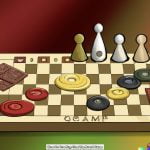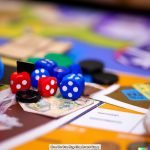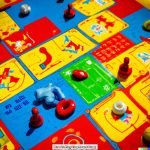Introduction
Clue Mysteries Board Game is a classic detective game that has been around for over 70 years. It was originally developed and marketed in the United States in 1949 by Parker Brothers as an alternative to the physical card-games and board games previously popular among family-gathering. The game has since become one of the most recognizable board games worldwide. Clue Mysteries Board Game is designed in such a way as to provide challenging yet stimulating mental exercise, involving thought, prediction and deduction. Players must use logic and observation skills to systematically eliminate suspects, rooms, weapons – all part of the fun challenge! The goal of the game is attend a dinner party at Manor House and solve the mystery surrounding it. Every character has his own motives and clues must be gathered in order to discover who committed which crime with what weapon in what room. Players take turns moving around the mansion, collecting clues whilst simultaneously uncovering bluffing stories from other guests. By combining knowledge gained from conversations with other characters and deducing from evidence collected from different rooms; a player may logically reveal who did it. By playing this entertaining board game together, families or friends can have hours of quality entertainment time whilst also learning valuable techniques that will help them become better problem solvers in their daily lives!
Object of the Game
Clue Mysteries (also known as Cluedo) is a popular board game designed for two to six players that involves mystery and deduction. The goal of the game is to be the first player to solve the mystery by correctly identifying who committed the crime, in what room, and with what weapon.
To play Clue Mysteries, the players must select a character—known as suspects—to represent them. Each suspect has their own unique personality and backstory which will inform their strategic move throughout the duration of the game. After characters have been selected, each player receives a secret clue card detailing which character, room, and weapon they hold.
Players then take turns rolling dice and attempting to move around different rooms in the mansion in order to gain incriminating evidence or receive clues from other players. The game ends once one player finds all of their “clues” and makes an accusation about who committed the crime using their collected knowledge. The remaining players either show their clue cards (if they still have them) or cross out possible suspects on their sheets until one player can definitively solve the mystery.
The recommended age range for Clue mysteries is 8 years old and up, though it’s reasonable that younger kids can play with adult supervision/assistance. This beloved deduction game is fun for both children and adults alike!
Setting Up the Board
To set up the board for a game of Clue Mysteries, begin by laying out all its pieces. The game includes 3 or 6 wooden tokens (which represent the players) and corresponding namecards, 12 cards containing suspects, weapons, and locations as well as 8 special clue cards. Then place the Detective’s Notes sheet which outlines which components each player receives after taking their turn near the board.
Next, put the board together so that it is facing all of the players equally. Starting with Ms Scarlet in one corner, position all of the suspect tokens around the board in numerical order then assign each player a token to use throughout their turn. When completed, those six tokens should be equal distances from each other around the playing surface.
Place all of the twelve cards containing suspects, weapons and locations into an envelope that can clearly be labeled and placed near to where players will sit (so they can easily pick them up when needed). Also make sure to thoroughly shuffle these cards so that each player has no idea what any others contain when picking them to gain information about themselves. Finally add in 8 clue cards facedown near to this envelope but be sure there aren’t too many exposed so that unsuspecting thieves don’t snatch them away!
Finally, once everything is in place make sure you have pens/pencils on hand for note-taking during gameplay along with spare pieces if anyone drops something during their turn. This will keep things running smoothly and aid accuracy!
Assigning Player Roles
Clue Mysteries Board Game is a fun, interactive game in which players take on the roles of well-known mystery fiction characters. Before playing, each participant must decide which character they want to be and assign themselves accordingly. Once all players have selected their characters, they must familiarize themselves with each character’s skills and abilities so that they can successfully contribute to the investigation.
Each character has special tools or items that can help them solve the mystery of Clue Mysteries Board Game. Sherlock Holmes, for example, carries a magnifying glass to inspect evidence while Miss Scarlet comes with a lock pick so she can gain access to certain locations. Other characters such as Dr. Watson have notebooks in which they can keep notes about their investigation and even interrogate suspects. Additionally, some characters will possess deductive reasoning or investigative intuition that make them prime suspects for solving the mystery.
Successful players will know how to use their character’s tools, detective skills and knowledge base to properly investigate clues throughout the game. Without strong expertise of each role’s tools and detective skills needed for success , no player will be able to ‘crack the case’, as it were, and players should jump into a few rounds before taking complicated situations too seriously.. As such, it is best for each player to read thoroughly on their assigned character prior to diving into gameplay!
Gameplay Walkthrough
Clue Mysteries Board Game is a classic game of deduction. The goal of the game is to be the first to solve the mystery by making accusations and collecting evidence. The game is played with up to 6 players, each with their own color-coded pieces representing characters, weapons and locations associated with the crime.
Before starting, have all players select one character playing piece each from Miss Scarlet, Professor Plum, Colonel Mustard, Mr. Green, Mrs. White and Mrs. Peacock and place them in their respective rooms indicated in the iconic Clue mansion box layout. All players should also choose which cards they’d like to represent their character – these cards provide necessary information needed during deduction or identification of other player’s evidence cards. After everyone has selected a piece and their cards are ready, the detective notebook—a kind of scoring sheet for all players—should be handed out as well so that when someone makes an accusation later in the game it can be marked as true/false.
The game starts with each player randomly drawing any three cards from the pile containing all 24 suspect, scenario and location cards; these represent potential suspects accordingly to who committed the deed to where did he/she do it with what weapon of choice; this serves as hints for all throughout the game play – hinting towards the possible solution for situation at any time throughout (excepting whenever only one person remains). Players should then take turns moving around map board while attempting to find clues within different areas or conversing with other participants before either making accusing somebody without sufficient evidence or trying identifying them by matching one another’s cards accordingly to identify perpetrator plus murder setting in getting closer towards solving mystery!. Furthermore as suspicions get confirmed occasionally regarding doubt on another player having certain items (e.g cards), then finally move forward by slowly narrowing down conviction until one manages correctly summing up this entire affair! Additionally due its quickness switching between topics shouldn’t generally cause too much disruption especially when great significance might arise immediacy concerning certain valuable insight claimed by others thus leaving no alternative than getting involved instantaneously thus increasing competition level here considerably more than expected originally!!
Advanced Strategies
The game of Clue, or Cluedo in some countries, is a brilliant and classic board game that has been around for generations. It is to the detective genre what Monopoly is to real estate – iconic, time-tested and timeless in its appeal. To truly succeed at this game it’s best to set up some advanced strategies and use tips and tricks to your advantage.
Solving the mystery of who murdered Mr. Boddy requires logical analysis combined with careful observation skills. To help you out, start by understanding the chances each suspect could potentially be the murderer: Firstly, make note of how many cards are in each stack–suspects, weapons, rooms–and then keep track of who has which cards while they are making suggestions in their turn. Watch how players respond when others make accusations as well; if they act surprised they could certainly be holding one or two of those cards or perhaps even all three! Through deductive reasoning you can draw accurate conclusions on whodunit very quickly. It’s also important to remember that any part of an accusation can disprove another player’s suggestion—so being polite pays off!
You would do well to apply variants to enhance game play every once in a while too. For example, playing “Murder in The Theatre” obtains a great deal more elements than simply an ordinary game of Clue both due to different suspects & 16 extra rooms allowing for countless possibilities within these added premises. This variation also introduces a whole host more customization choices wherein players plot out different routes throughout the theatre differentiated by secret passages and additional obstacles like locked doors requiring careful scrutiny throughout their investigation into figuring out the correct answer to whose side ultimately won this age-old mystery!
Tips on Teamwork
Teamwork is essential in the game of Clue Mysteries Board Game. You need to be able to coordinate with your partners, strategize and decide who will look into which elements of the game.
A great way to work as a team is to start by agreeing on one main action plan. Pick someone to take notes of all deductions and findings, in order to avoid confusion and overlapping. Before every move each player should have an idea of what should be investigated, so that time is not wasted delving into unnecessary topics.
Communication between groups is important too – don’t forget to talk strategy whenever you can! Everyone should feel comfortable with expressing their opinions, sharing ideas and debating on possibilities; be open-minded when listening to others.
At some points you might want to split up your group in order for everyone to investigate clues individually – taking turns goes a long way! Decide how best to split depending on the situation and what seems fair but remember that this divides effort and resources needed for an effective investigation – weigh out the pros and cons before making each decision.
Helpful Hints & Strategies
Clue Mysteries Board Game is a great way to bring the traditional detective experience with a fun, interactive game. To play, everyone starts off the same – each player chooses a “suspect” character and begins by picking a leading card. You then arrange the 9 rooms in an overturned configuration. Every turn includes moving up to three spaces, taking a guess as to who “did it” in what room with what weapon, or making an accusation.
When selecting your suspect character it is important to take into account the different advantages each one has. For example Miss Scarlet is more likely to get around quickly once revealed due to her higher max movement. On the other hand, Mr Green may help protect your card from being seen if you are playing against others that know how to read people effectively. It can be beneficial to select your Suspect accordingly!
At the start of each round all of the cards will be face down. As you make your moves, it is important that you use your clues and deduction skills carefully in order to figure which cards remain unseen. Make sure you keep an eye on which pieces your opponents have crossed off and focus on those clues in order narrow down possibility’s for who did not commit the murder in question. Additionally some strategies for success include deducing which weapons were used most often during game play – as this can help identify key suspects as well! Finally, always remember that making good guesses as soon as possible will increase your chances at victory .In addition, keeping track of other players’ movement can also be helpful… allowing you gain insight into their movements based off their own investigation and deduction efforts!
Conclusion
Clue Mysteries board game is a classic deduction game for up to six players. In this game, you take on the role of one of the six well-known characters suggested in the official rules and prepare to solve a mysterious case. Each character has a full set of tokens used to keep track of solved clues and reach conclusions. At the beginning of the game, three cards are secretly hidden in one of the rooms indicated by Mr. Boddy – these cards contain information on which character committed the murder, with what weapon, and in which room! The object of Clue Mysteries board game is to be the first player to figure out all three answers correctly.
Now that we have covered how to play Clue Mysteries board game, let us review some best practices and other resources for further exploration into this classic game. To ensure success and avoid getting stuck on any particular puzzle, it is recommended that players work together as a team and use observational skills to put together clues from various sources. If stuck on any individual puzzle element within the game, players should consult online tutorials or look online for extra help from experienced gamers. With enough practice and collective deduction skills between friends, anyone can become an expert detective at this timeless board game!

I love playing all kinds of games – from classics like Monopoly to modern favourites like Ticket to Ride.
I created this blog as a way to share my love of board games with others, and provide information on the latest releases and news in the industry.





